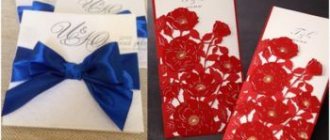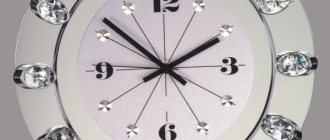A Tatar wedding is an important event for a future Muslim family. This is a unique celebration with rich national rituals. Compliance with the Muslim traditions of the ancient people makes the Tatar wedding original and truly colorful. In this article, the portal svadbagolik.ru will tell you about the features of a Tatar wedding.
Matchmaking: the beginning of preparations for the celebration
Parents on both sides find out the family ties between the young people up to the seventh generation. If there is no relationship between the bride and groom, the wedding is possible.
After this, the matchmaking process can be divided into three stages:
- bride's viewing,
- stories about the groom,
- negotiation.
At the last stage, all material issues are discussed, including the size and components of the dowry. The bride price, according to Tatar traditions, is paid in full on the wedding day or earlier.
An interesting fact is that the size of the bride's dowry is not discussed. If both parties agree, the bride donates a hand-embroidered towel or woven tablecloth, and the groom's relatives donate money. The matchmaking ends with a magnificent feast.
Fabrics and decor
If previously the most popular material in the costumes of the Tatar peoples was velvet, supplemented by several meters of braiding made of gold threads, today the assortment has certainly expanded. Increasingly, synthetic fibers are being added to natural fabrics to make dresses more practical. Wedding dresses are usually made from satin, brocade, dupont, and jacquard. As throughout the world, the trend is the finest lace, emphasizing the femininity, tenderness and airiness of the wedding look.
Numerous modernized wedding dress design ideas mostly have European roots. Tatar embroidery is something that has remained unchanged in wedding dresses: colorful golden ornaments and floral motifs adorn the sleeves, hem of the skirt, veil or hijab. This distinctive feature gives the bride a special charm, femininity, royal uniqueness, and such decoration looks very expensive and sophisticated.
Wedding ceremony Nikah: wedding in Tatar style
Nikah is an official part of a Muslim wedding, one of the most beautiful ancient traditions. Tatar weddings take place 1-2 weeks after matchmaking, in the bride’s house or in a mosque. At the Nikah ceremony there are male witnesses, the groom's father or his close relative and a Muslim priest - a mullah.
A prerequisite for the religious ceremony is that the bride and groom must be Muslims. Nikah begins with the recitation of a prayer and lasts about an hour. According to ancient tradition, the bride must keep her face covered at all times, but in our time this is practically not observed.
Next, you need to draw up a marriage contract and declare the groom’s obligations. After sealing the agreement, the mullah reads a chapter of the Koran.
Young people can register their relationship at the registry office after Nikah.
What are Tatar style wedding ceremonies called?
What is the name of a Tatar wedding? Entry into a Tatar family union is divided into several stages. Some are folk in nature, some are more religious. In any case, it is consistent action that will ultimately help create a harmonious family.
Each process involves different family members. There are even stages in which future newlyweds do not take part.
Matchmaking
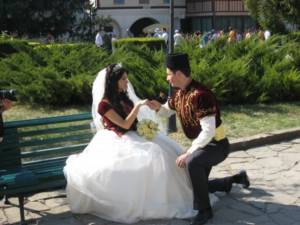
The groom's mother and father determine future matchmakers. As a rule, this is two people. One of them is a close relative (brother, uncle). The second is a knowledgeable person who knows how to make a match. The guests go to the bride's house, where she should treat them to tea and pamper them with home-cooked food.
Matchmakers should look at the girl, talk to her and her parents. Subsequently, they need to tell the groom’s parents the positive aspects of their future daughter-in-law. The girl's mother and father listen to the groom and matchmakers who talk about what kind of person their daughter's future husband is.
Parents are interested not only in character traits, but also in financial income , material well-being, and the availability of real estate. The young lady's father makes demands for ransom for his daughter. The matchmakers go home to talk with the groom's parents. Everyone is considering whether to continue with the wedding or not.
Bride ransom
If the decision is positive on one side and on the other, the man must give a bride price for his future wife. This is a kind of ransom offered by the bride's relatives. Ideally, the size of the bride price should exceed what was originally requested.
The girl’s parents have every right not to marry her off until they receive the funds they requested. The better and richer the young lady, the more bride price is required for her. A few days before submitting the application to the registry office, the groom presents gifts to the bride's relatives.
Nikah
Tatar wedding - nikah. What's special? A religious Tatar ceremony, attended only by real Muslims in national costumes. Nikah, as a rule, is held without the bride and groom. This ritual is performed by a mullah. He reads the Koran, says prayers, spiritual instructions and messages. All those present pray for the future family, their luck, harmony and happiness.
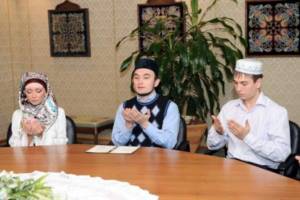
Nikah is a closed ceremony , attended mainly by respected and revered family members. As a rule, these are grandparents. Before Nikah, future spouses are prohibited from spending time alone and communicating face to face.
Tui
The solemn wedding event itself is called thuja. It is carried out in several stages. According to tradition, thuy itself is celebrated in the bride's house. Currently, the Tatars have slightly modernized their traditions and hold weddings in a restaurant.
There's nothing wrong with that either. If the thuja is held in the house of a young lady, then a luxurious table is set there, to which relatives, neighbors and friends are invited. The event is accompanied by a noisy feast, national music and dancing.
The Tatars have one interesting custom that is performed during thuja - the wedding dance of the newlyweds. A tent is covered on the street and the newly made spouses dance under it, and the guests must hold the ends of the tent and dance with it. It is believed that this beautiful custom can bring good luck and happiness to the home of the newlyweds.
Wife moving into husband's house
After the thuja has been celebrated, the man must pick up his wife from her father’s house. The day after the wedding, the bride and groom go to the house of the groom's parents, where they will live. Tatar brides travel with their dowry.
The men in the groom's house lay pillows or carpets under the feet of the young wife. This is considered a kind of sign of respect and veneration. The women bake a pie and treat it to the newlyweds, flavoring it with honey and sugar. The ceremony is performed by the groom's mother and sisters. This is done so that the relationship between the daughter-in-law and new relatives is sweet.
The girl goes to the bedroom along with her dowry. In it, she replaces the curtains and bed linen and hangs a towel on the hook by the door. Often young ladies come with rugs and lace pillowcases.
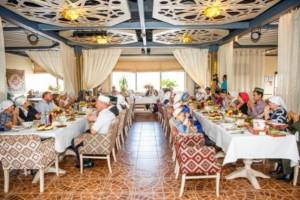
Beautiful Tatar weddings.
On the one hand, this girl shows what wealth she has. On the other hand, what a housewife and needlewoman she is. Therefore, it would be better to sew or knit something with your own hands. When all the customs and rituals are observed, the newlyweds go to the table and continue the festivities.
Feast
Traditionally, the feast at Tatar weddings is different from any other. This is due to the fact that there is an abundance of national dishes on the table. In addition, customs are followed. There is always no alcohol at the gala event. This is considered a bad sign and bad manners.
Recently, Tatars have often begun to add European dishes to the menu. For example, popular salads or hot appetizers.
However, what has remained unchanged is that there are always several traditional dishes on the table:
- Shurpa is required to be served. This is a soup or stew made from beef broth with the addition of homemade noodles and vegetables. The soup is served before the hot main course. It is brought in portions in deep plates with national Tatar ornaments.
- As a hot main course, two roasted geese are served on a large plate. They are a symbol of the bride and groom. The most honored guest at a wedding is trusted to cut up the birds. This must be done so that all the bones remain intact. The bride and groom bring the treats to their guests one piece at a time.
- Chak-chak and gubadia are two dishes that are served at the end of the event and serve as a kind of replacement for the European cake. Chak-chak is prepared by the bride's relatives. Perhaps everyone knows what kind of oriental sweet this is. It is laid out in a large mound on a plate. Before serving, the bride’s sister goes around the guests with a plate and collects money for the treat. Afterwards, the aunt or older sister of the young bride cuts the oriental sweetness and serves it to the guests. The fourth part of the treat is cut off and given to the girl’s mother. After the wedding, she should distribute it to neighbors and friends who were not present at the wedding event.
Gubadiya is prepared by the groom's relatives. This is a closed meat pie. Its presentation is interesting: it is served on a plate and covered with a beautiful scarf. On top, guests shell out money for a piece of delicious baked goods.
Later, the groom's brother or uncle cuts up delicious pastries and distributes them to the guests. Just like with chak-chak, a fourth part is given to the groom's mother, who must later distribute the pie.
Tui is a multi-day holiday among the Tatars
The celebration of a Tatar wedding does not take place in one day and can last several days, or even a week, in the houses of the bride and groom alternately.
There are several stages of celebration:
- Feast at the house of the bride's parents.
- Wife moving to her husband.
- Partying at the groom's house.
Nowadays, Tatar wedding celebrations are increasingly being replaced by cafes and restaurants. And thanks to the Tatar wedding scenario, the holiday turns out to be especially cheerful and bright.
In the design of a banquet hall, both standard decorative items can be used - balls, ribbons, garlands, flower arrangements, as well as national attributes, for example, plates with Tatar symbols, embroidered tablecloths, and items with ornaments.

Wife moving into husband's house
After the tui has been celebrated, which can last for several days, the husband takes his wife to his home. Traditionally, the bride sits by the window, and women come up to her and begin to stroke her head and calm her down. At this time, the girl should cry, sad that she is leaving her father’s house.
A man goes with his chosen one to his parents' house. Previously, it was there that a young family began to live before a separate home was built or purchased. The father and male relatives of the groom lay carpets in front of the daughter-in-law or place a pillow under her feet. This is a sign of respect and honor.
A daughter-in-law can gift her relatives with handmade items. A national shirt is suitable for the father-in-law, and for the mother-in-law it is better to choose a beautiful patterned scarf.
The girl is escorted to the bedroom where she will live with her husband. The bride lays out new bed linen, hangs curtains and puts down rugs. Thus, he demonstrates his thriftiness and his dowry.
Traditional Tatar wedding dishes: an abundance of taste
No Muslim wedding is complete without a goose. Its removal is accompanied by the presentation of gifts and money. Only a man is trusted to butcher a goose.
In addition, at the beginning and at the end of the celebration, tea with sweets is served. As for alcohol, according to tradition, mash is allowed.
Another traditional Tatar delicacy at weddings is chak-chak. It is a sweet dish made from dough, it surprises with its ease of preparation and has a delicious taste. This sweet is traditionally prepared by the mother of the bride.
The wedding table contains an abundance of compotes, fruits, vegetables, soups and meat dishes.
Traditional stages of a wedding
A Tatar wedding begins long before the wedding day.
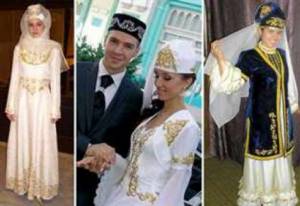
The traditions of a Muslim wedding firmly cement the union of two hearts. After all, both sides of relatives participate in the preparation of the main ceremony. They take upon themselves the solution of the first everyday issues that can cause discord in the new family. So, the customs of preparing for a wedding.
- Matchmaking takes place without the participation of the future newlyweds. Future relatives agree on the ransom amount - kalym. It also turns out whether the future spouses have relatives up to the seventh generation.
- Kalym in the customs of a Tatar wedding is a serious rite. The groom must give gifts not only to the bride, but also to all relatives. The bride, in turn, prepares her dowry. It usually includes clothes for the spouse, towels and rugs.
- The bride's viewing is when the groom's relatives, during negotiations about the wedding, watch and evaluate how the bride pours tea and looks after them.
- The bride must also express her consent to the candidacy of her future spouse. Modern young people, of course, have discussed everything for a long time and agree to have a wedding. However, the bride must nod her head to the mullah's questions about the groom's candidacy. In the old days, the bride had to cry loudly - and thus express her consent.
- An engagement is an announcement that the bride is now a girl of marriageable age who is getting married soon.
- After the engagement, preparations begin for official registration and a long feast.
KNOWLEDGE BASE: Hollywood style wedding - feel like a star
Official registration precedes the rite of entering into an alliance before Allah. All couples first register with the registry office and then contact the priest. Nikah or nikah is a meeting of young people with the mufti. The ceremony is carried out either in the mosque or at the bride’s home. The young people either read the oaths or repeat the words of the oaths after the clergyman. An interesting fact is that the mufti asks the bride what gift she wants from the groom. It could be gold jewelry, building a house, anything. And during the ceremony, a deadline is set for the fulfillment of the wish.
After registration on earth and in heaven, a feast begins, which lasts at least two days. According to tradition, the first day is celebrated in the bride's house, without the groom's relatives. On the second day, the groom takes the bride to his place. The holiday continues without the bride's relatives.
Meeting the bride at the groom's house: interesting traditions of the Tatar wedding
According to Tatar rules, the meeting of the bride is accompanied by a particularly warm and hospitable welcome. Special honor is given to the guest by placing pillows under her feet. Then the bride is treated to bread and honey in the name of good-hearted relations with her mother-in-law and the groom's sisters. And if the bride dips her hands in flour, prosperity and prosperity await the newly-made family.
The ceremony of consecrating the home by the bride deserves special attention. Hanging up new towels and curtains, as well as laying out rugs, gives the bride the right to get comfortable in the new home, and the groom's relatives to look at the dowry.
The move ends with a magnificent feast.
In Rus'
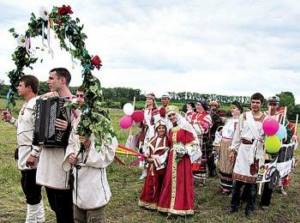
Russians considered odd numbers of the month to be the happiest time for matchmaking. However, in no case was it possible to get married on the thirteenth, as well as on Wednesdays and Fridays. In order to avoid the evil eye, this should be done late in the evening, after sunset.
Before entering the girl's house, you had to lightly touch the door frame. The matchmaker was the godfather or another relative of the groom. A mother could also become a matchmaker. Sometimes a respectable woman, especially respected in the village, was invited to be a matchmaker.
There was no way to talk about the wedding directly. For this purpose, certain allegories were used in Russian matchmaking rituals, such as the famous: “You have a product, we have a merchant” or “You have a duck, we have a drake.”
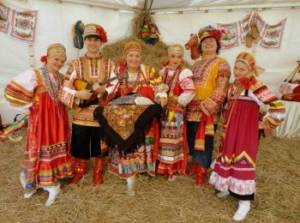
In some areas of Russia, it was customary for the bride, demonstrating her attitude towards the young man, to sweep the floor during matchmaking: if the girl swept towards the stove, this meant that she liked the groom, but if towards the door, then no.
During the matchmaking, the bride was supposed to remain silent, but she was supposed to change her best outfits three times . The bride also publicly showed her embroidery, hand-woven lace, knitted and woven items.
If the consent of the girl’s parents was obtained, then the groom and his parents left the hut to once again discuss the virtues of the chosen one. When they returned, the girl’s mother brought the groom a drink. If he emptied the entire mug, it meant that he still intended to get married; if he only took a sip, the wedding was cancelled.
Traditional wedding dresses: Tatar wedding dresses
Special requirements for the wedding dress are imposed on the bride, a symbol of modesty. Tatar long wedding dresses, not necessarily white, should cover the entire body: arms, décolleté and neck. The bride's head must be covered. An alternative to a wedding dress can be trousers with a tunic.
The Tatar wedding dress of the groom is almost any version of a European wedding. These are all kinds of suits in black, dark or gray colors, shirts, ties, tuxedos. It is obligatory for the groom to have a skullcap on his head.
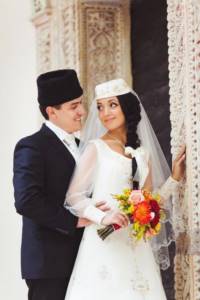
The traditions of a Tatar wedding are in some ways similar to wedding traditions in Russia, because it involves matchmaking and a lavish feast. But Muslim customs are distinguished by their special flavor and solemnity. This is a big holiday from which a happy family life begins! You can learn more about the wedding traditions of the peoples of the world on the portal Svadbaholik.ru.
Video: traditions and customs at a Tatar wedding
A Tatar wedding celebration, held in accordance with all traditions and customs, is a big holiday from which the long, happy life of a young married couple begins. The sacred vows that the newlyweds make in front of the mullah and close relatives give the religious event a special solemnity and strengthen the family union for many years. Warm words, sincere wishes of relatives, joy, happiness for the newlyweds will remain in the memory of the newlyweds and wedding guests for a long time.
Even if you decide to organize a modest event, simplifying the ceremony or abandoning several Tatar wedding rituals, remember that the main meaning of the pious Nikah is to strengthen love for each other. When creating a union, do not forget about mutual respect and trust between spouses, which are a strong foundation for any married couple. Watch the beautiful, touching Tatar wedding ceremony in the video:




